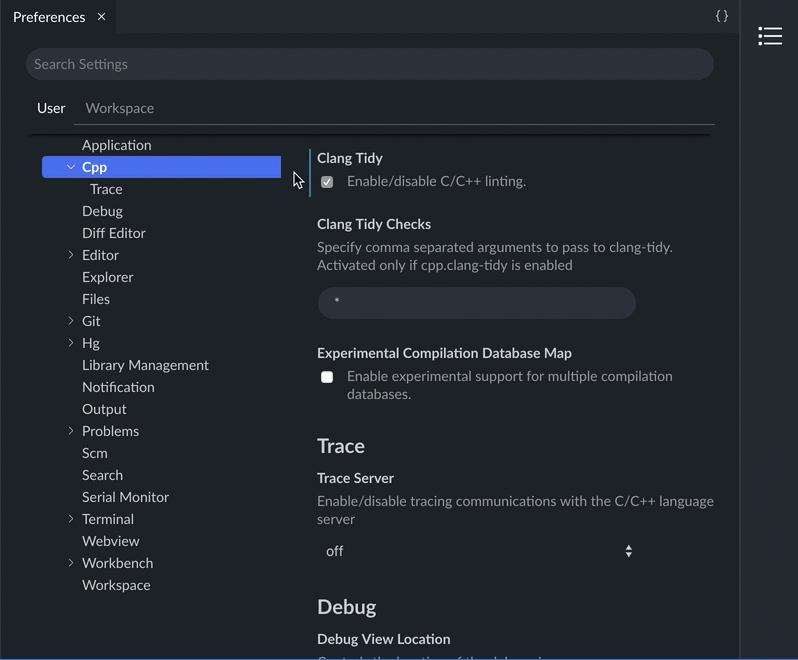Changing preferences
You can customise many of Mbed Studio's behaviours to suit the way you're used to working: how you edit and browse files, how you debug, how you use the terminal and so on.
To change preferences:
-
Go to File > Settings > Open Preferences.
Two tabs are displayed: a User tab and a Workspace tab. In the User tab, you can define preferences that apply to all workspaces. In the Workspace tab, you can define preferences for the workspace currently open only. Preferences set in the Workspace tab take precedence over preferences set in the User tab.
See Default and custom workspaces for more details on workspaces.
The Open Preferences in JSON icon
 opens a JSON file storing all the preferences you changed from their default values.
opens a JSON file storing all the preferences you changed from their default values. -
Select the User or the Workspace tab. If you have several workspaces and want to define preferences by workspace, make sure you have selected the correct workspace first (use File > Open Recent Workspace... to switch between workspaces).
-
Click the preference that you want to change and modify the predefined values as needed. Note that for some preferences, you can add a manual value in the JSON file.
-
For preferences that require a manual value, when you click the Edit in settings.json link, a preference ID is added in the JSON file and you then need to add the correct value.
For example, if you click Edit in settings.json for the Files preference, the JSON file opens in a separate tab and shows the
files.associationsID without a value; you can then associate new file extensions to a language:``` { "files.associations": {"*.myextension": "cpp"} } ```In this example, your files with a
*.myextensionextension will be recognized as C++ files.
Once you have changed a preference, a blue line and a cogwheel icon appear to the left of the preference. You can click the cogwheel icon and select Reset Setting to reset the preference. You can also copy the preference ID and the value set for the preference in JSON format (Copy Setting as JSON option), or copy the preference ID only (Copy Setting ID option).

You can look for a specific preference by typing its name or ID in the Search Settings field.
In the following example, Mbed Studio will:
- Only open files on double-click (instead of single-click).
- Use
\r\nfor the end of line character (instead of matching the operating system). - Not auto indent.
- Use a larger font size in the terminal (15 rather than the default 12).
- Not ignore white space changes when comparing files.
- Auto close brackets only before a white space.

You can change the most common preferences without going to the Preferences list. For example, go to File > Settings > Color Theme, to switch from the default dark theme to a light theme, or click the Spaces option on the information bar to indent with tabs.
Setting word wrap preferences for the editor
You can control word wrap in the editor through the Word Wrap preference. By default, this preference is off but if you set it on, text will wrap at the editor window's width.
Two other options are available for Word Wrap and work in combination with the value set for the Word Wrap Column preference. Word Wrap Column is the maximum number of characters that can be displayed on a single line.
- wordWrapColumn: When this option is selected, text wraps at the value set for Word Wrap Column.
- bounded: When this option is selected, text wraps at the editor window's width or at the value set for Word Wrap Column, whichever is the minimum value between the two widths.
Once you have set these preferences, select View > Toggle Word Wrap to toggle between the different options for the Word Wrap preference.